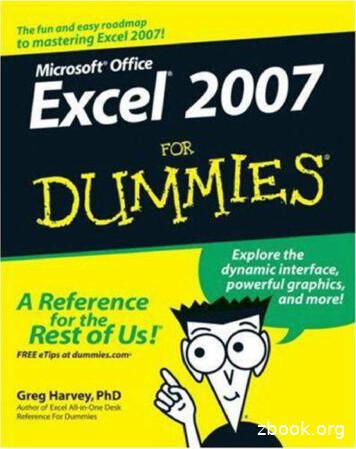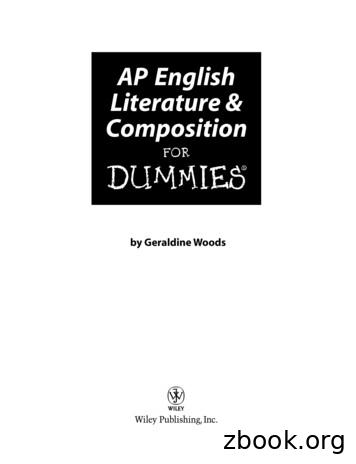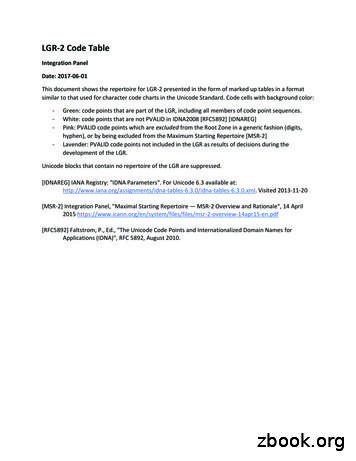Arabic For Dummies
ArabicforDummies
Nada ShaathBell High SchoolBell, California2007- 2008
What is the Arabic Language? An alphabetical Language with 28 lettersHas its own alphabetical charactersOf Semitic origin (root)Spoken by about 186 million people in 28 countriesConsidered a very difficult language due to its vast vocabulary andspecial grammatical characteristicsCan be classified into 3 forms: Classical ArabicModem Standard ArabicLocal dialects ﻣﺮﺣﺒﺎ Hello
The root of Arabic اﻟﺴﻼم ﻋﻠﻴﻜﻢ Greetings (Peace be upon you)
Arabic alphabet
Arabic alphabet
Arabic alphabet: History The Arabic alphabet was used to write the Nabataean dialect ofAramaic,The first known text in the Arabic alphabet is a late fourth-centuryinscription from Jabal Ramm (50 km east of Aqaba), but the first datedone is a trilingual inscription at Zebed in Syria from 512.The epigraphic record is extremely sparse, with only five certainly preIslamic Arabic inscriptions surviving, though some others may be preIslamic. ﺻﺒﺎح اﻟﺨﻴﺮ Good morning
Arabic alphabet: Structure 28 basic letters andIs written from right to left.There is no difference between written and printed lettersThe writing is unicase (i.e. the concept of upper and lower case lettersdoes not exist).Most of the letters are attached to one another.The Arabic alphabet is an impure abjad ﻣﺴﺎء اﻟﺨﻴﺮ Good day (evening)
“Dots” in the Arabic alphabet Arabs relied on their extensive knowledge of their language todistinguish one letter from another having the same shape.Later “Dots” were added above and below the letters to differentiatethemThe first surviving document that definitely uses these dots is also thefirst surviving Arabic papyrus, dated April 643. ﻟﻴﻠﺔ ﺳﻌﻴﺪة Good night
Diacritics in the Arabic alphabet Short vowel and hamzas were added, beginning sometime in the lasthalf of the sixth century,Initially, this was done by a system of red dots, said to have beencommissioned by an Umayyad governor of Iraq, Hajjaj ibn Yusuf: a dotabove a, a dot below i, a dot on the line u, and doubled dots govetanwin. However, this was cumbersome and easily confusable with theletter-distinguishing dots, so about 100 years later, the modern systemwas adopted. The system was finalized around 786 by al-Farahidi. اﻟﻰ اﻟﻠﻘﺎء See you (later)
Arabic short vowels The Arabic language graphically has only three short vowels.These vowels aren't written in the body of the word, but they are addedabove or under the consonant to which they refer.In general, Arabic is written without short vowels.The "fat70:" and the "kasr0:" are represented by a dash put respectivelyabove and under the consonant they are associated with. The"Damm0:" instead it is like a small "wAw" (see the alphabet table) and itis written above its consonantWhen the target languages of the transliteration are European in origin(Germanic or Arabic, the short vowels are "a," "i," and "u." verses Longvowels ("aah," "ee," "00")Arabic Short vowels need not be added during vowelization.Transliteration and Roman name generation اﻟﻰ اﻟﻠﻘﺎء ﻗﺮﻳﺒًﺎ See you soon
Vowels in the Arabic alphabet Vowels in Arabic can be short or long (, i.e., held for a longer time)The Arabic alphabet does not represent the short vowels at all, and hassymbols for only the three vowels, [aa], [ii], and [uu]: رﺟﺎء Please
Consonants in the Arabic alphabet Arabic has some "back" and "heavy" consonants"Heavy" consonants are: ﻣﺒﺮوك Congratulations
Consonants in the Arabic alphabet "Back" consonants:ً ﺣﻈًﺎ ﺳﻌﻴﺪا Good luck
Alphabet PronunciationSome examples of points of articulation
Non Arabic Languages that use ArabicAlphabet Hausa 39 millionKashmiri, 4.5 millionKazak 8 million peopleKurdishKyrghyz,. 1.5 million speakersMalay 18 millionMorisco: No longer usedPashto19 millionPersian/FarsiSindhi 9 million speakersTatar 9 million speakersTurkish 70 million speakers (now it’s using Latin alphabet)Uyghur 7.6 millionUrdu 104 million speakers اهﻼ وﺳﻬﻼ Welcome
GrammarThe basic grammar of the spoken language differsconsiderably from English.
Word Structure: Tri-literal Root System Words has one root that is the three letter past tense of the verb.The three-letter root system is best described by an example:The three letters k-t-b, for example, carry the basic meaning "write."Various combinations of the letters—always, however, in the k-t-border—with vowels and other consonants produce words that arevariants on the basic meaning "write." For example:(Most educated Arabs can readily list many words from one root.) اﻟﻮداع Good-bye
Word Structure: The Arabic Article The definite article [al - the Arabic word for "the.“] It is prefixed to thefollowing word, and, depending on what consonant that word startswith, the [l] may be dropped and the first consonant doubled.Many English words that have been borrowed from Arabic still have thedefinite article attached—for example, alkali, alcohol, alchemy,algorithm, algebra, and almanac.Many Arabic masculine names also include the definite article. ﻣﻊ اﻟﺴﻼﻣﻪ With peace (bye)
Word Structure: Nouns and Adjectives All Arabic nouns (including those which denote inanimate objects) aremasculine or feminine, with the feminine nouns usually ending in [-a] -.The plural marker for masculine nouns is the suffix [-iin]The plural for feminine nouns is the suffix [-aat].There are also many irregular plurals in Arabic, which have to bememorized individually, like the irregular plurals in English ('child–children', 'mouse–mice', etc.) إن ﺷﺎء اﷲ God willing
Sentence Structure: Word Order Written Language: Word order is verb-subject-object.Spoken language: Word order is subject-verb-objectMost noticeable are the differences in word order. For example,adjectives come after nouns, instead of before: "the teacher good"instead of "the good teacher." ﻣﺮﺣﺒﺎ Hello
Punctuation in Arabic Most punctuation marks used.Arabic punctuation is now similar to western style punctuation,Some of the symbols are inverted or reversed, e.g. a reversed questionmark and comma.The use of full stops and commas is more realxed than English. اﻟﺴﻼم ﻋﻠﻴﻜﻢ Greetings (Peace be upon you)
Vocabulary in classical Arabic Spoken Arabic is close to written ArabicNumerous similarities among dialects.vocabulary differences are related to the local environment, includinglocal dress, tools, names of plants and animals, for example (Jameedin Jordan). ﺻﺒﺎح اﻟﺨﻴﺮ Good morning
Antonyms in Arabic A strange phenomenonThe reason is attributed to the Bedouin origin and it is believed that thecontradictory extremes of life seem to be the same in essenceThere are words that mean one thing as well as its opposite.e.g Saleem one who is curedSaleem one who just been bit by a snake“Love” has 77 names (Hawa, ishq, hayam, fitna, fanaa)e.g Fanaa loveFanaa To Fanish ﻣﺴﺎء اﻟﺨﻴﺮ Good day (evening)
Arabic is a flexional or analytic language. The Arabic language allows expansion of vocabulary by adding thecombination of long and short vowels e.g Yaktob, Kaateb,Maktoob,Kataeb, Ketabah, etc this gives the Arabic language vocabulary tobe more flexible and more accurate.The Arabic language is measured same as music measurements andhas its own rules when it comes to writing poetry. ﻟﻴﻠﺔ ﺳﻌﻴﺪة Good night
Classical Arabic, literature: classical poetry Literary works written in the Arabic language.The great body of Arabic literature includes works by Arabic speakingTurks, Persians, Syrians, Egyptians, Indians, Jews, and other Africansand Asians, as well as the Arabs themselves اﻟﻰ اﻟﻠﻘﺎء See you (later)
Historical View
Pre-Arabic in the Middle East In Egypt the common language was some form of Coptic.The Levant was even more complex: The Jewish people spokeAramaic as their native tongue, but used Hebrew as their liturgicallanguage.Some Christians had developed Syriac, a special form of Aramaic.Greek was the language of the administration.In Sinai Desert of Egypt, the Negev Desert of Israel and most of Jordanand the Golan region of Syria Ghassanids spoke Arabic.In Mesopotamia Pahlavi was spoken by the population and was alsothe official language of administration. اﻟﻰ اﻟﻠﻘﺎء ﻗﺮﻳﺒًﺎ See you soon
Theories about Pre-Islamic Arabic رﺟﺎء Please
Classical Arabic literature Pre Islam 4th-7thCentury The poems are strongly personal qasidaThe qasida survive only through collections, chiefly the Muallaqat,Hamasa, Mufaddaliyat, and Kitab al-AghaniPopular Poets: : Amru al-Kais,Antara, andZuhair. ﻣﺒﺮوك Congratulations
Classical Arabic literature Pre Islam 8thCentury In Baghdad a group of young poets arose who established a new courtpoetryPopular Poets: Abu Nuwas,Abu al-Atahiya,Mutanabbi,Hariri,Abu al-Ala al-Maarri,Omar Ibn al-Faridhً ﺣﻈًﺎ ﺳﻌﻴﺪا Good luck
Islam and the Arabic Language Islam has kept the Arabic language from vanishing by connecting itto the Quran.Islam added new vocabulary that was not used before.Some of the pre-Islam vocabulary has vanishedAdding new meanings as a way of expanding the vocabulary:Moemen, Salat, zakat.Creating new proverbs that enriched the Arabic language اهﻼ وﺳﻬﻼ Welcome
QuranThe Quran: The Holly Book of Islam, and the word of God according to thismonotheistic faith was originally revealed to Mohammad in Arabic The Quran kept its original form from its revelation until now Is considered the ultimate script for classical Arabic اﻟﻮداع Good-bye
Classical Arabic Literature/ post Islam 19th cent., printing in Arabic began in earnest, centered in Cairo,Beirut, and Damascus.Newspapers, encyclopedias, and books were published.Classical Arabic, Modern Standard Arabic and Dialects were used.New forms developed (novel, drama, and short story)Novelist Naguib Mahfouz, winner of the 1988 Nobel Prize in Literature,The playwrights Ahmad Shawqi and Tawfiq al-Hakim,The poets Hafiz Ibrahim, Badr Shakir as-Sayyab, Nazik al-Malaikah,Abdul Wahab al-Bayati, Mahmoud Darwish, and Adonis,The short-story writer Mahmud Tymur ﻣﻊ اﻟﺴﻼﻣﻪ With peace (bye)
Forms of Arabic
Classical Arabic, Modern Standard Arabic,and Colloquial Arabic Classical Arabic:The text of the Qura’anModern Standard Arabic:Standardized form of Classical Arabic used in all countries of the Arab world. Itis used in printed material, media, and in all official delivery (speeches,radio, television). Colloquial Arabic:Colloquial Arabic is the form of language used in daily communication betweencommon people إن ﺷﺎء اﷲ God willing
The current form of Arabic –Modern Standard Arabic (MSA) MSA is Arabic, some sources do not distinguish between MSA andClassical Arabic at all.Practically, in a classical Arabic text, you can expect very richvocabulary (for instance, the sword can be expressed using dozens ofnames!), while in MSA your expectation are to read without having toreference a dictionary.MSA is the lingua franca used and respected by educated Native ArabSpeakers and Muslims throughout the entire world.MSA is used in the media (TV, newspapers, magazines), for educationand for religious communications (mosques and churches).Some universities in the west use MSAPeople from different countries (i.e., different dialects, e.g., a Moroccanand a Kuwaiti) tend to use MSA when the local dialect fail incommunication. ﻣﺮﺣﺒﺎ Hello
Current geography of dialects Maghreb ArabicAndalusi Arabic (extinct)Egyptian ArabicSudanese ArabicLevantine ArabicIraqi ArabicGulf ArabicNajdi ArabicYemeni Arabic اﻟﺴﻼم ﻋﻠﻴﻜﻢ Greetings (Peace be upon you)
Is it hard to learn Arabic?Yes and NoEasy when you understand it: The root system of Arabic Grammar, especially since irregularities are not common The normal word order of a sentence is verb/subject/object It is logicalTough to handle unless you gave it proper time: The rich and extensive vocabulary Arabic has many regional dialects The correct pronunciation of "heavy" letters of the Alphabet ﺻﺒﺎح اﻟﺨﻴﺮ Good morning
Arabic Native SpeakersTop 12 Languages of the 500600Speakers in Millions700800
Words of Arabic origin in EnglishAdmiral,adobe, alchemy, alcohol, alcove, alembic, alfalfa, algebra, algorithmAlkali, almanac, amalgam, aniline, apricot, arsenal, arsenic, artichoke, assassinAubergine, azure, barbarian, bedouin, benzine, Betelgeuse, bint, borax, cableCalabash, calibre, caliph, camel, camise, camphor, candyCoffee, cotton, damask, dhow, dragoman, elixir, fakir, fellah, garble, gauzeGazelle, ghoul, Gibraltar, giraffe, grab, guitar, hashish, hazard, henna, hookahJasmine, kafir, khamsin, khan, kohl, lemon, mosque, muezzin, mufti, mullahNadir, orange, ottoman, racket, safari, sesame, sheikh, sherbet, sofa, spinachSultan, sultana, syrup, talc, tariff, tarragon, Trafalgar, vega, vizier, wadi, zenithzero اﻟﻮداع Good-bye
Thank you ﺷﻜﺮا ﻟﻜﻢ
Hausa 39 million Kashmiri, 4.5 million Kazak 8 million people Kurdish Kyrghyz,. 1.5 million speakers Malay 18 million Morisco: No longer used Pashto19 million Persian/Farsi Sindhi 9 million speakers Tatar 9 milli
Trademarks: Wiley, the Wiley Publishing logo, For Dummies, the Dummies Man logo, A Reference for the Rest of Us!, The Dummies Way, Dummies Daily, The Fun and Easy Way, Dummies.com, and related trade . Excel Workbook For Dummies and Roxio Easy Media Creator 8 For Dummies, . Greg went on to teach semester-
Dummies Way, Dummies Daily, The Fun and Easy Way, Dummies.com and related trade dress are trademarks or registered . English Grammar For Dummies, English Grammar Workbook For Dummies, Research Papers For Dummies, College Admissions Essays For Dummies, SAT I . Getting the Story from Prose
Dummies, Solaris 9 For Dummies, Fedora Linux 2 For Dummies, and Linux Timesaving Techniques For Dummies. Gurdy Leete is a co-author of OpenOffice.org For Dummies, a technical editor for Free Software For Dummies, and the co-author of five other popular com-puter books. He’s also an award-winning software engineer and a co-author of
113 70 0645 arabic letter meem 114 71 06ba arabic letter dotless noon 115 72 0646 arabic letter noon 116 73 0648 arabic letter waw 117 74 0624 arabic letter hamzah on waw . 121 78 0649 arabic letter alef maqsurah 122 79 06d2 arabic letter ya barree 123 7a 06be arabic letter knotted ha 124 7b a
ﺑﺮﻌﻟا The Beginner's Guide to Arabic GUIDE TO STUDYING ARABIC 2 WHY STUDY ARABIC 2 HOW TO STUDY ARABIC 3 WHERE TO STUDY ARABIC 4 WHAT YOU NEED BEFORE YOU START 4 THE ARABIC ALPHABET 5 INTRODUCTION TO THE ALPHABET 5 THE LETTERS 6 THE VOWELS 11 SOME BASIC VOCABULARY 13 RESOURCES FOR LEARNING ARABIC 17 ONLINE 17 RECOMMENDED BOOKS 18 OUR NEWSLETTERS 19 by Mohtanick Jamil . Guide to .
Bruksanvisning för bilstereo . Bruksanvisning for bilstereo . Instrukcja obsługi samochodowego odtwarzacza stereo . Operating Instructions for Car Stereo . 610-104 . SV . Bruksanvisning i original
About the Author Geraldine Woods teaches English and directs the independent study program at the Horace Mann School in New York City. She is the author of more than 50 books, includ-ing English Grammar For Dummies, SAT For Dummies, Research Papers For Dummies, College Admission Essays For Dummies, AP English Literature For Dummies, and AP English Language and Composition For Dummies, all .
0644 arabic letter lam 0645 arabic letter meem 0646 arabic letter noon 0647 arabic letter heh 0648 arabic letter waw 0649 arabic letter alef maksura 064a arabic letter yeh tashkil from iso 8859























